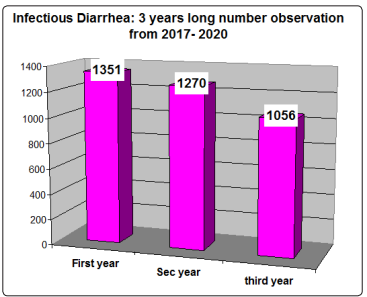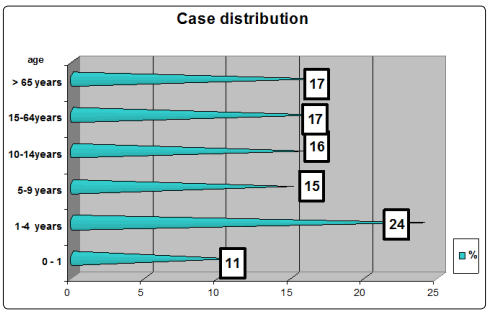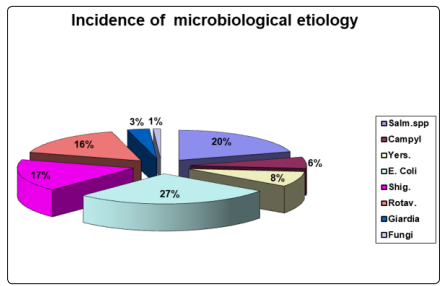Author(s): Liana Monica Deac
Diarrhea had to be understood from medical point of view, as an alteration in a normal bowel movement characterized by an increase in the water content, volume, or frequency of stools. Acute diarrhea of infec¬tious etiology, referred to gastroenteri¬tis and is associated with clinical signs and symptoms including: nausea, vomiting, abdomi¬nal pain and cramps, bloating, flatulence, fever, passage of bloody stools, tenesmus, and fecal ur-gency disorders. In fact, Infectious diarrheal diseases, are the second leading cause of morbidity and mortality worldwide and can cause real public health problems. Such diarrhea was studied as a medical disorder, in a 3 year period, 2017-2020, in Transylvania region from Romania. We have found out 3577 number of cases, data which were transmitted by 12 district Sanitary Polices, to the Public Health Center. This all were mostly diagnosed by the territorial family doctors and more than 50%, have need hospitalization, for several days, because of several disease disorders. The detected infectious etiology, were determined in authorized laboratories, by identified: Shigella spp, Salmonella spp, Campylobacter spp, Yersinia spp, Rotavirus, Giardia. Most number of cases appeared in children, followed by elderly or adult people, as quantified number of determined infectious diarrheas. Acute diarrheal illness had to be considered a major public health issue, against which control efforts are needed. Public health surveillance of infectious acute diarrhea, include obligatory strategies of infection control.
Admitted According to the World Health Organization (WHO) and UNICEF data, there are about 2 billion cases of diarrheal disease worldwide on every year, and 1.9 million children younger than 5 years of age, mostly in developing countries, perish from diarrhea each year. In industrialized countries, relatively few patients die from diarrhea, but the disease continues to be an important cause of morbidity associated with substantial health care costs. However, the morbidity from diarrheal diseases has remained relatively constant during the past 2 decades [4].
Because off all these data, it was studied in the Epidemiology Department, of the Public Health Center, in a 3 years long period, 2017 - 2020, the morbidity caused by infectious diarrhea, which appeared in Transylvania region from Romania. Despite the economic and societal burdens of diarrheal illnesses, few clinical guidelines exist worldwide, for the diagnosis and treatment of persons with suspected or relevant infectious diarrheas. That for considerable clinical practice has to be observed for to demonstrate a clear need for a clinical diagnostic improved guideline
With an analytical descriptive epidemiological study, there were analyzed 3577 cases of infectious diarrhea in the Transylvania region population. All these for to figure out all representative aspects of these pathology in: children, adults and elderly people. Data recruitment were ordered by the existing Ro national public health guidelines and were transmitted by the territory sanitary police units, during 5 months, from May to November between 2017-2020 and were sent to the Public Health Center Cluj- Epidemiology Department, where it was done an detailed epidemiologic study with all received data interpretations.
This total of 3577 number of Infectious diarrhea, are shown as relevant data in Fig 1.

Figure 1: Infectious Diarrhea during 2017-2020
Most of the disease were present in the first year of the study, in 37%, followed by 35, 5 % in the second year and at least in 29, 5% in the third one. In all 3 years, most of this pathology appeared in the summer season and almost during July to August, in the entire studied territory and it was not a significant estimate difference to be remarked. The case incidence for the disease arrived at 65%, in the summer seasonal morbidity, and was represented in special in July and August. In rest infectious diarrheal did not represent a specific morbidity in Transylvania region. Significant to be figured out is, that infectious diarrhea existed at each age decade, but more significant in children, with 63%, as Fig. 2 present data.

Figure 2: Distribution of the Disease
The disease was at children at 0-14 age present. Most children on the decade 1-4 age were the reported cases. In adults infectious diarrhea was remarked in 17%, as well in elderly people this pathology was represented in same number also, by 17%. 27% of cases from children and adults have need short hospitalization times and it was asked because of dehydration. For this disorders it was used a specific adequate fluid and electrolyte replacement as key of the treatment, to managing diarrheal illnesses. Even so, 3 children under 5 year’s age died, after this specific therapy, because of severe complications. Organic failed was estimate to be the cause of their deaths. There is also a growing awareness of the potentially huge impact, in the developing world, of long-term disability caused by repeated early childhood enteric infections. It is estimated that, worldwide, there are 3.1 million deaths due to diarrhea per year (18400 per day), mostly of young children in developing areas [1]. Annual deaths due to diarrhea globally occur mainly in young children, and the number of deaths is 1000-fold higher than in the United States, where most of those who die of diarrheal illness are elderly [2].
Clinical and epidemiological evaluation must define the severity and type of illness. For clinicians, early diagnosis of an acute episode of diarrhea, can lead to interventions that alleviate symptoms and prevent secondary possible transmission. For public health practitioners, prompt notification of pathogen-specific diagnoses and bacterial isolates through public health surveillance, can low the rates of transmission and lead to timely detection and control of outbreaks. Because both clinicians and public health practitioners share overlapping responsibilities for the diagnosis, management, and prevention of infectious diarrheal diseases, must contain specific recommendations and specific guidelines for both groups [5].
Diarrheal illness is a problem worldwide, with substantial regional variation in the prevalence of specific pathogens. Diagnostic testing of stool specimens was indicated for Patients, up to an existing national guideline to identify them. That for, it was significant to be figured out, the etiological aspects concerning all detected infectious diarrhea. Data came from several territory laboratories as pertinent investigations. All this data were identified, in order to present the microbiological discovered aspects, during the 3 years study. With, it was possible to make an overview, concerning the heterogenic microorganisms, who made the appearance of the infectious diarrhea diseases present in the Transylvania population. The incidence of this aspects, is presented in Fig 3.

Figure 3: Overview of the Detected Etiological Aspects
Most of species belonged to the Enterobacteriaceae Family, represented by E. coli in 27 %, Salmonella spp. in 20 %; Shigella spp. in 17%. Important is to be figured out here even, that the death of the 3 children under 5 age was caused by invasive E. coli , present in their stool samples. Natural, it is also important to be remarked the presence of Yersinia spp in 8 % and of Campylobacter spp. in 6% in other patients samples. The presence of this different bacterial aspects, were for E. Coli in the disease cases, at almost in children faces identified, but all other mentioned species were even in adults, or elderly people samples, detected by the territory laboratories. The observation of this study, even must mention in 17 % the Rotavirus cause, which mostly were present in the infectious diarrhea of children as etiological aspect. 3 % of children have had even Giardia and 1% of elderly people have had Fungi in their preserved tools. Many of these organisms are easily transmitted through food or water or from one person to another as the epidemiological study figured out results in the territory
There are various interpretations of what is considered medically indicated for evaluating persons with diarrhea. Stool cultures are often viewed as tests with a high importance [3]. With the rapid globalization and industrialization of our food supply and with a multiplicity of recognized pathogens and diagnostic tools, the challenges of determining optimal, cost-effective means for appropriate diagnosis, clinical management, and public health control of diarrheal illnesses are great [6]. This will continue to evolve as improved understanding of pathogenesis and development and use of inexpensive, rapid tests improve diagnosis and management of infectious diarrheal illness, one of the most common clinical syndromes in our society. The lack of a specific diagnosis can hinder appropriate management and treatment of many infections. Observation of patients is a recommendations intended to provide clinicians and public health practitioners with a consensus-based document that will aid in the management of acute diarrhea by addressing which patients to test, what tests to order, next what medical treatments to use, and what steps to take to ensure that appropriate public health actions are implemented.
There was no specific difference of data in the 3 years done study and infectious diarrhea appeared almost during summer months, July- August.
The incidence of infectious diarrhea was significant at Children, 0-14, but each patient should be observed about potential epidemiological risk factors, for any diarrheal diseases, or for their possible spread infection in the territory.
All diarrheal pathogens, as bacterial, viral, and parasitic, had to be identified, for evaluating each persons with enteric infections.
To reduce the morbidity and mortality associated with infectious diarrhea, needs clinical and public health studies, that require specific control measures in clinics and health care activity group, to identify optimal diagnostic, treatment, and prevention methods.
